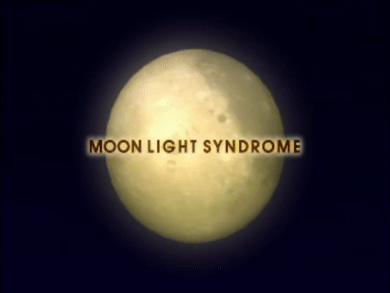Program: Noguchi, Toshio | Sound: Niikura, Kouji | Screenplay: Suda, Goichi
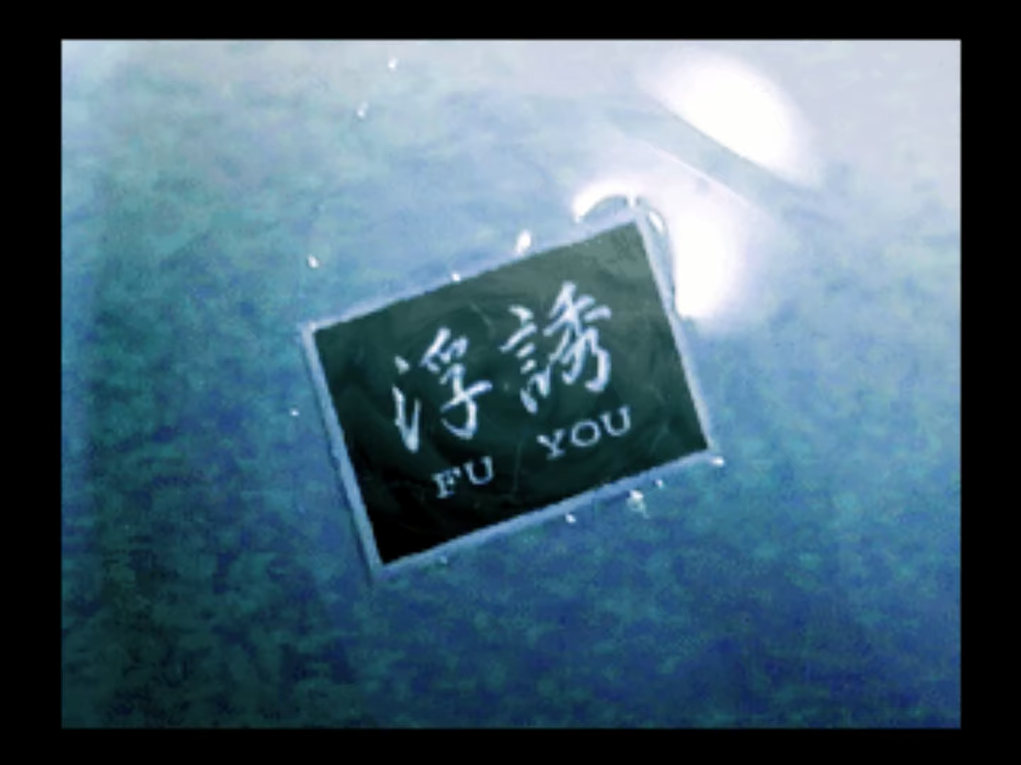
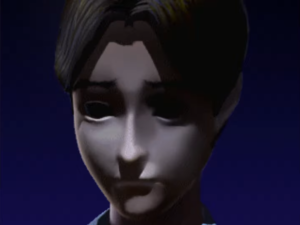
The chapter opens on a boy, alone on the roof of an apartment complex. From the building next to him, boys around the same age are staring at him. The boy, haunted by their stares, jumps to his death.
When the camera pans to the other roof again, we can see that it’s now empty, all the other boys having disappeared.
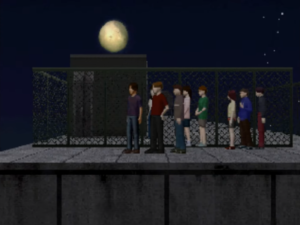
The next morning, Mika excitedly recounts the incident to Yukari.
The boy we saw in the previous scene was actually the third in a series of suicides perpetrated by middle-schoolers, living in an apartment complex dedicated to public housing located near Mika’s home. (This is also where we find out that Mika’s apartment complex, the pyramid condo, is considered a high-income location.)
Mika, as she is want to do, ropes Yukari into investigating the suicides; she eventually relents.
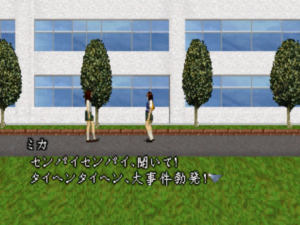
Arisa and Chisato then show up. We are told that Arisa is actually Chisato’s underclassman in the archery club. Archery is associated with Shintoism and, more generally, with Japanese traditionalism.
We know from the Twilight Syndrome games that Chisato is a highly spiritual girl who was often the only one able to truly connect with the spirits the trio would encounter; Moonlight Syndrome actually hints at the fact that Chisato herself is a supernatural being, an angel on par with Yayoi. Arisa is presented as an “apprentice” to Chisato not just as an archer, but as a spiritual guide and ESPer: While younger and less experienced than her senpai, she will eventually display similar powers and sensibilities.
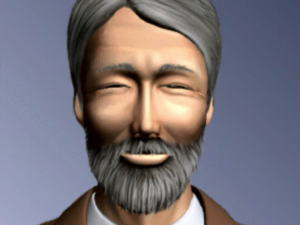
Arisa is then introduced to Yukari, who is quickly annoyed by her child-like attitude. Chisato and Mika, however, seem fond of it and insist that Yukari will warm up to her. The four joke around the fact that much like Arisa is setting herself up as Chisato’s successor, Mika is taking after Yukari, becoming “Yukari 2”. Yukari proudly declares herself to be the sexier of the two and leaves the scene. Chisato and Arisa then inquire about whichever subject she and Mika were discussing before their arrival (that is to say, the suicides.)
In the next scene, Arisa is helping Mika look for her lost PHS. On their way to the library, where Mika saw it last, the duo encounters the headmaster. His appearance is jovial and relaxed, as opposed to the monstrous visage he will reveal later in 慟悪 DOWAKU.
He knows Arisa and Mika by name, claiming that their homeroom teachers have been saying good things about them, but of course he actually knows them by surveilling the school through his hidden cameras and by collecting their measurements for his “hobby”.
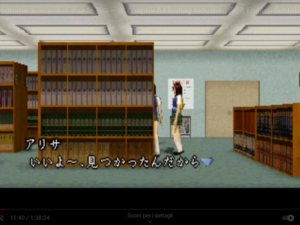
The girls eventually manage to secure Mika’s PHS in the library. However, it is found in a corner of the library that Mika hadn’t visited at all, implying this to be another one of Mithra’s pranks.
The two then have a quick exchange about the value of technology in society; Mika claims that she’d be unable to survive without her PHS, while Arisa, possibly due to her more traditional edge and Chisato’s influence, says that her generation (despite her being just one year younger than Mika) puts a lot more value in personal time, and in that context toys such as Mika’s phone can only impede progress.
At sundown, Mika is waking by the apartment complexes where the suicides take place. She wonders where Arisa is, implying that after the conversation at the start of the chapter both her and Chisato were also invited to the investigation.
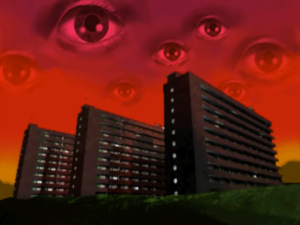
Mika will elect to try and call Arisa; if she chooses to redial her last number, however, she will hear Mithra’s voice, taunting her by reminding her of Sumio’s death, which she is still in denial about. When she calls Arisa’s house, her mother confirms that she is on her way to their meeting spot, but she just left the house, so it’s gonna take her at least half an hour to get there.

Mika spots one of the kids going inside the apartment complex and moves to follow her; however, she stops when she finds the chalk outline of the previous day’s suicide. As she looks at it she is accosted by three kids, Takeru, Hiroshi and Rukawa, who start threatening her for crossing into their territory.
Mika can either go along with their threats or talk back at them; regardless, the trio eventually leaves her alone. From their words we can infer that their leader is a girl named “Riru”, and that Takeru is the least bloodthirsty of the three. In fact, depending on Mika’s choices, he’ll be the one to deescalate the situation.
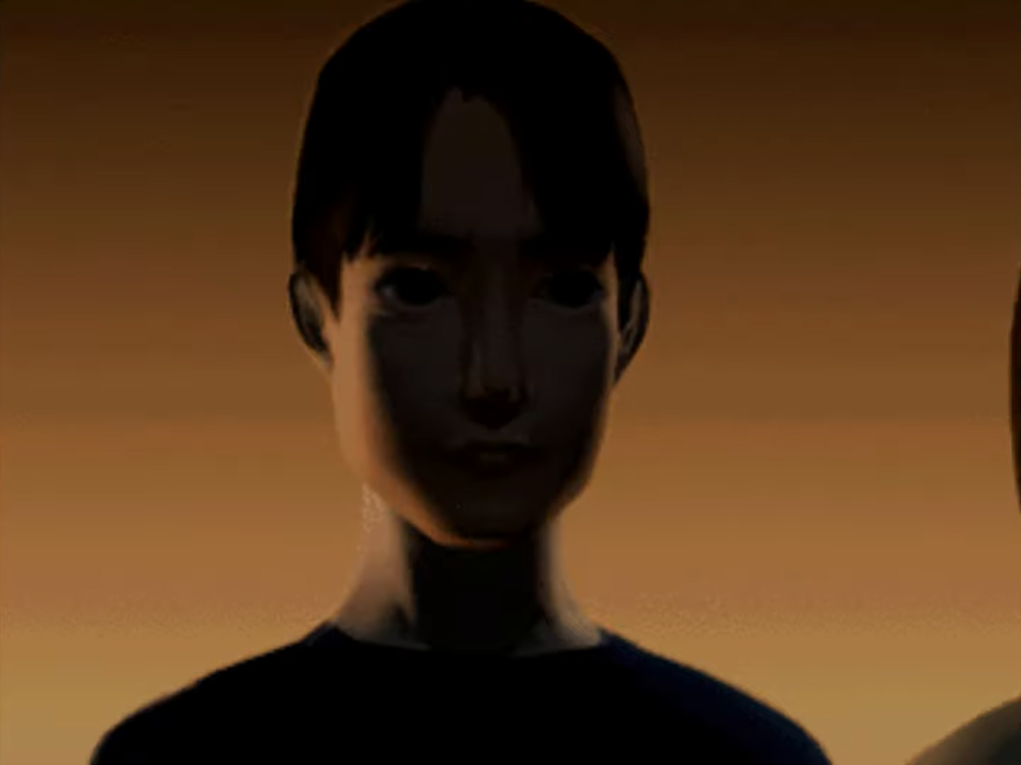
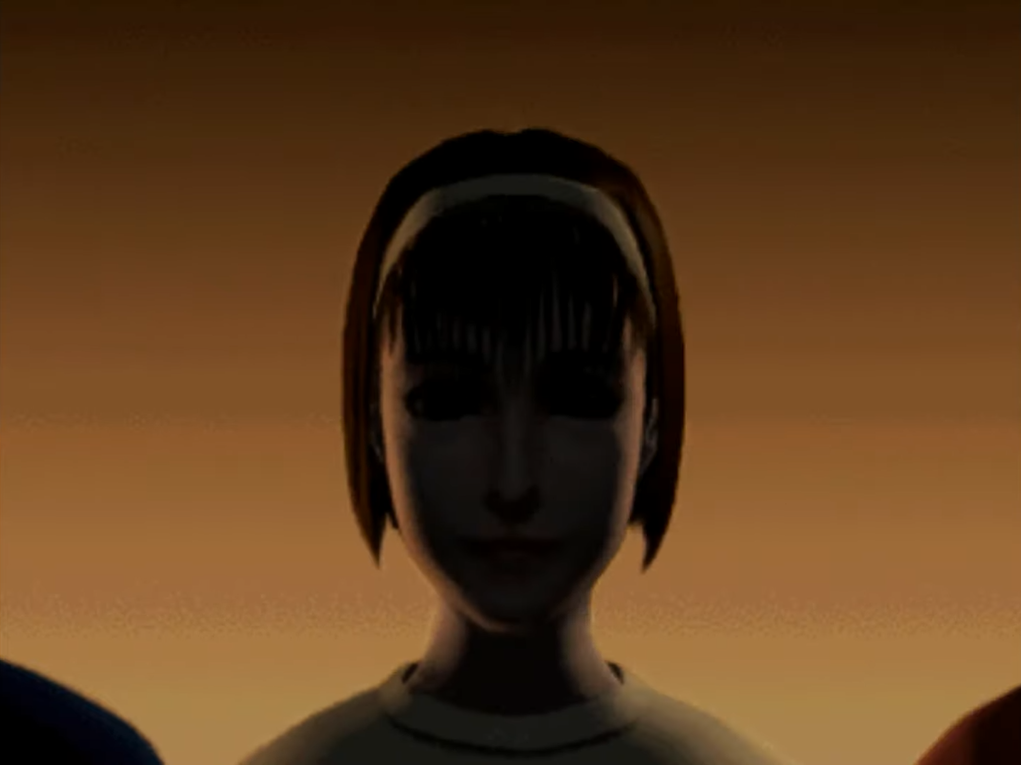
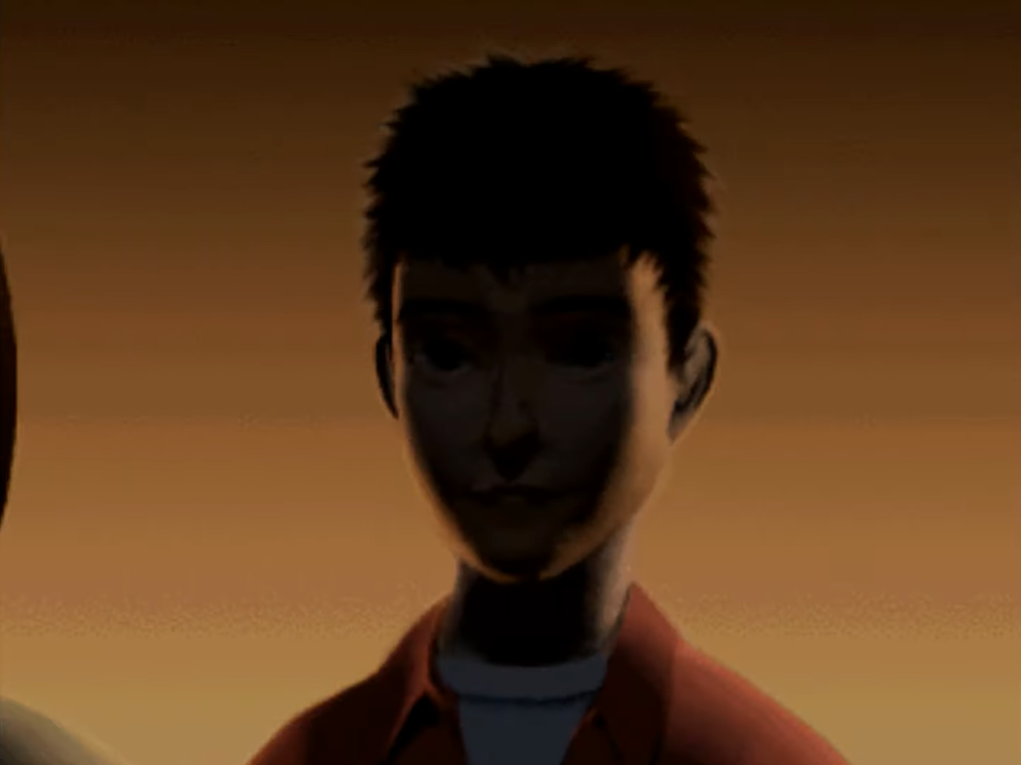
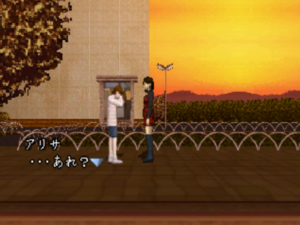
Talking with either of the three kids (the game will jump to the next scene after talking to any one of them, which means that getting through all the different conversations requires multiple playthroughs) will reveal that they are seemingly terrified of their leader Riru, they resent Mika’s generation for supposedly ruining the world around them (not dissimilarly to what Arisa told Mika in the library earlier in the chapter) and that the suicides are somehow connected to these two factoids.
Arisa then arrives on the scene, but before she’s able to meet up with Mika she stumbles onto a crying girl called Nana. (She’s the same girl that Mika saw enter the complex earlier.)
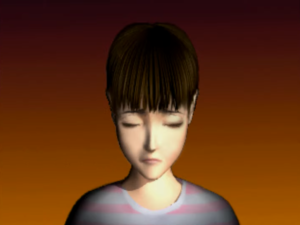
When asked, Nana says that she is crying because of Takumi’s death, the boy who jumped the day before. However, she hated Takumi: her tears are not caused by grief, but instead by the fact that since Takumi is dead, Nana will be forced by Riru to jump that very night. Arisa decides to help her and instructs her to lock herself in her apartment and wait for her while she finds Mika.
Mika and Arisa meet up and explain the respective situations to each other. The path here branches slightly: Mika can either choose to follow Arisa to Nana’s apartment or try and look for Riru in order to put a stop to the suicides before it can affect Nana. Regardless, Nana will be lured away by an apparition of Arisa, tricking her into believing that she has come to help.
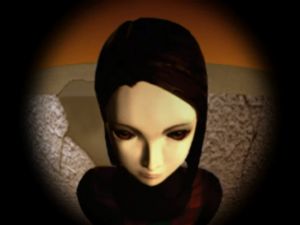
This can be very confusing on a first playthrough; however, the In-depth Guide Q&A confirms to us that Riru was herself under a contract with Mithra. It seems that when Mithra is involved, in order to fulfill the contractor’s wishes, reality can be warped, allowing for Riru to take the shape of Arisa in this instance.
Depending on your previous choices, either Mika and Arisa will go look for Nana together and later meet up with Takeru, or Mika will meet up with Takeru while Arisa goes to look for Nana. In either case, Nana is nowhere to be found, and Takeru is alerted by either Mika or both of the girls that she has been taken by Riru in order to be sacrificed.
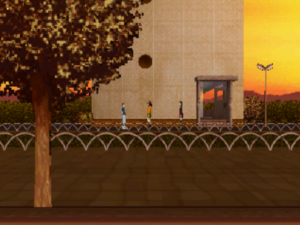
Takeru actually has some attachment to Nana, so in order to protect her he gives hints as per the location of Riru: While nobody knows exactly where she lives, she was at one point spotted leaving the A-block. If Arisa was present she will immediately run to A-block, while Mika will tell Takeru that if he really means to protect Nana he needs to take action immediately rather than let his fear of Riru get the best of him. It is at this point that she also notices how in maturing, she is becoming more similar to Yukari.
Regardless of the player’s previous choices, Arisa will disappear and Mika will have to investigate the A-block by herself, by checking the apartments whose lights are on.
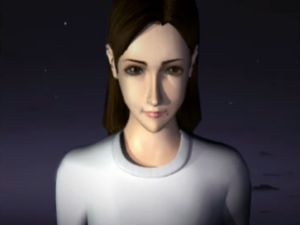
After the sun goes down, Chisato and Yukari finally arrive at the meeting spot. While discussing Yukari’s attachment to Mika and her reluctance to face up to it, the duo is accosted by Yayoi.
She greets Chisato as her sister, which confuses Yukari.
Chisato, having recognized her, infers as per role in the situation. Yayoi responds that she is with “him”, referring to Mithra. Despite Chisato’s accusations, Yayoi denies having instigated the current situation (the mass suicides), claiming to just be a neutral observer, much like Chisato.
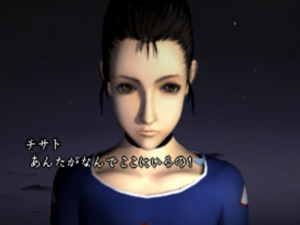
She responds by saying that “they” (as in human beings in general I guess) are harmless compared to Yayoi, to which she retorts that the pollution and chaos caused by humankind is far from harmless. This seems to imply that her (and by proxy Mithra’s) motivation for wrecking havock in Hinashiro is a sort of revenge from the spiritual world onto the world of humans; however, Yayoi is often shown as a hypocritical liar, so I’m assuming she was just trying to confuse Chisato here.
When asked about Mithra’s location, Yayoi responds that he is watching over them, witnessing everything that is transpiring. She then insults Yukari, by saying that despite all she heard about, she’s nothing but a naïve girl. Yukari claims not to care about the opinions of a little girl. (Yayoi is, or at least appears as, Chisato’s little sister, meaning that she’d also be younger than Yukari.)

Yayoi and Chisato both manifest auras and begin a spiritual battle; Yukari, caught in between them, is teleported away by Yayoi on the roof of the apartment complex, where Takumi killed himself the night before. Yayoi claims to have been done so in order to “give Yukari a chance”; in fact, being up on the roof is what will give Yukari the opportunity to prevent Nana’s suicide later.
At the same time, Mika is investigating Riru’s apartment block. She finds that each doorbell she rings she is always greeted by middle-school children, and that they’re mostly terrified of Riru.
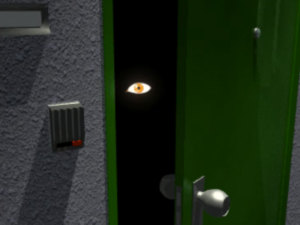
As the doors open, we see the individual eyes that go on to form the eye collages we’ve been seeing through the chapter. Mika has to investigate the complex on foot, since the elevator is also controlled by the kids.
Mika eventually receives a hint from a ghostly voice; She seems to recognize the voice, however she can’t quite place it. That’s because it actually belongs to Hanako-san, the first ghost Mika and her friends met at the beginning of Twilight Syndrome. Later in the chapter Hanako-san will be revealed as a facet of Chisato herself, meaning that she was indirectly trying to help Mika here.
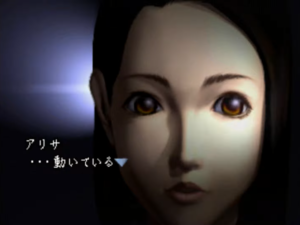
Regardless, thanks to said hint, Mika is finally able to locate Riru’s apartment. As she rings the doorbell, she is invited in. Arisa, whose location is unknown at this point, perceives that both Nana and Mika are in danger.
Nana is then shown on the roof, ready to jump, with Yukari trying to talk her down. Yukari can be more or less successful in reaching out to Nana, who feels like she can’t meaningfully connect to anyone, but regardless of her words she will eventually choose to jump, claiming that “this is what this place (the apartment complex) wants” and that by diving she will finally change things.
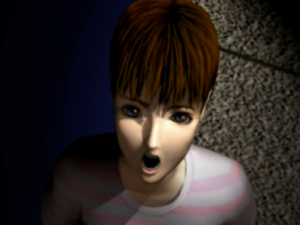
This is when the meaning behind the eyes imagery we have been seeing through the chapter becomes apparent: the eyes (which we saw individually as Mika was investigating the apartments, and as a collective in the backgrounds and in several shots) represent peer pressure, or a consensus that is created by the people surrounding you which eventually ends up influencing your own actions.
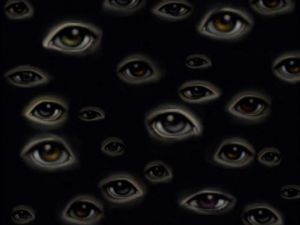
That is why, despite there being noone on the opposing roof witnessing the suicides, Nana (much like Takumi in the intro) still feels that their “eyes” are on her, it is a will created by consensus that cannot be opposed by the individual. This creates an interesting parallel with Mika, whose personality is also shaped around group consensus and the idea of “belonging”.
In the following segment, Mika is conversing with Riru. While Mika is under the impression that the suicides are orchestrated by her, Riru claims that she is nothing more than a symbol, a conduit for the zeitgeist of apartment life, which she compares to a pulse or frequency.
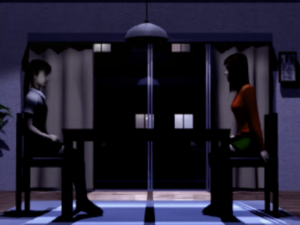
Since all of the families in the public housing area are comprised of double earners (keep in mind that this is taking place during the recession in a low-income area) the kids are mostly left to their own devices.
Little children are either being cared for at the nursery or are alone in their homes watching tv, elementary-schoolers hang around by themselves playing videogames, and high-schoolers don’t come home till late in the evening. Therefore, the middle-schoolers are cut off from everyone else, with Riru even questioning if apartment complexes are suited for the development of a nuclear family at all. She also points out how despite investigating the complex, Mika didn’t run into anyone her own age, since they hang out in their own closed circles, making it unsurprising that girls like Nana would be afraid of them.
What her rhetoric is getting at here, is that the phenomena of mass suicides by these middle-schoolers, who long to destroy the current zeitgeist by sacrificing each other in order to attract their parents’ attentions, was not willed into being by any specific person or entity, much as Yayoi said. It was caused by the familial structure that was imposed on them by the economy and the urbanization wave itself, what she refers to as the ecosystem that was created during the past twenty years.
It actually reminds me of a passage from the Unabomber manifesto (I’m not claiming it was a direct inspiration. Just that they tackle similar themes.) describing how technological and economic development are actually way more influential in the lives of the citizens than whichever form of government is in place.
94. By “freedom” we mean the opportunity to go through the power process, with real goals not the artificial goals of surrogate activities, and without interference, manipulation or supervision from anyone, especially from any large organization. Freedom means being in control (either as an individual or as a member of a SMALL group) of the life-and-death issues of one’s existence; food, clothing, shelter and defense against whatever threats there may be in one’s environment. Freedom means having power; not the power to control other people but the power to control the circumstances of one’s own life. One does not have freedom if anyone else (especially a large organization) has power over one, no matter how benevolently, tolerantly and permissively that power may be exercised. It is important not to confuse freedom with mere permissiveness (see paragraph 72).
Source
95. It is said that we live in a free society because we have a certain number of constitutionally guaranteed rights. But these are not as important as they seem. The degree of personal freedom that exists in a society is determined more by the economic and technological structure of the society than by its laws or its form of government. [16] Most of the Indian nations of New England were monarchies, and many of the cities of the Italian Renaissance were controlled by dictators. But in reading about these societies one gets the impression that they allowed far more personal freedom than our society does. In part this was because they lacked efficient mechanisms for enforcing the ruler’s will: There were no modern, well-organized police forces, no rapid long-distance communications, no surveillance cameras, no dossiers of information about the lives of average citizens. Hence it was relatively easy to evade control.
In other words, it is the building itself which is claiming the lives of its inhabitants, much like Nana has said, by being a space which was built around the specificities of western-capitalist economic structures, which were imposed on Japan after capitulating in WW2 and in turn eroded the traditional Japanese family unit. Suda himself, being a child of divorce and having to live through several hardships because of it, would obviously be sensitive to the theme of broken families (which he would eventually revisit in Kurayami Dance).
Mika asks Riru what she can do to help stop this, to which Riru responds that she must tell the outside world about the lives the middle-schoolers live. Alone in dark rooms, isolated from each other as if each apartment were its own pocket dimension, the pulse convinces them that by protesting in the only way they can (by taking their own lives) they can eventually change things. Riru resolves to do something to stop the suicides, after which Mika is either drugged or knocked out by force.
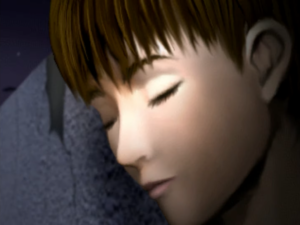
Yukari comes down from the roof and finds out that Takeru has in fact saved Nana from falling thanks to Mika’s encouragement, to which she is impressed by Mika’s maturity.
Yukari and Arisa finally meet up in front of the building and recap the events they have witnessed; meanwhile, Riru thanks the unconscious Mika for finally giving her a reason to act; she realizes that as a symbol she is powerless, but by evolving into a substance, she can finally take enough control to change things.

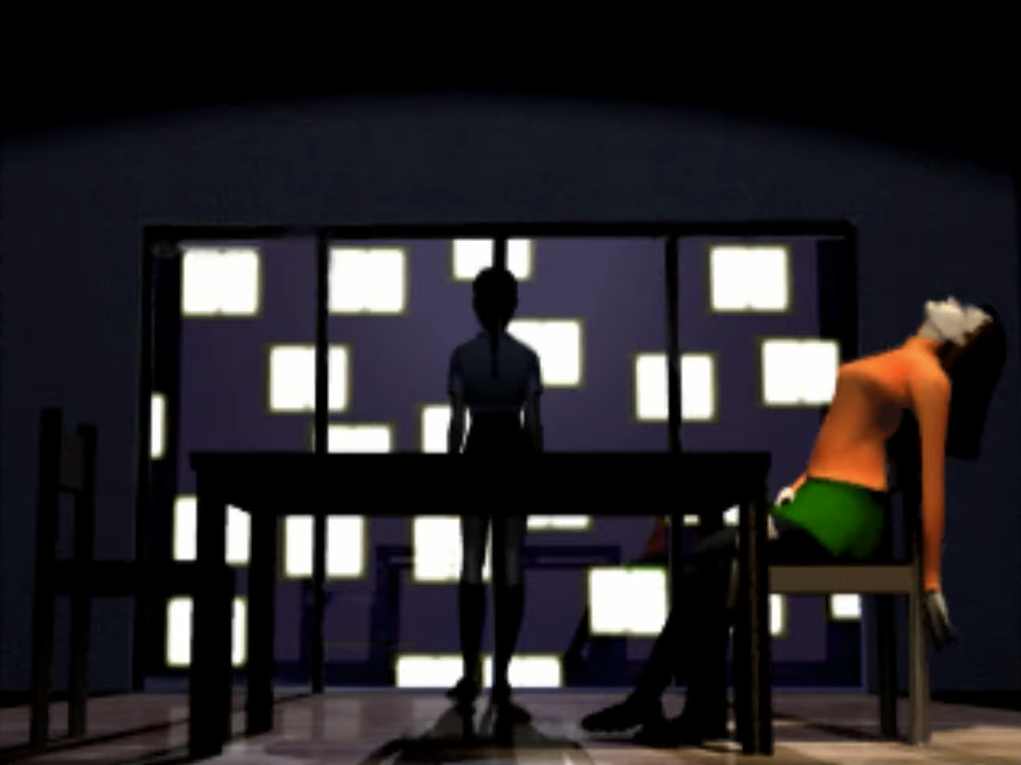
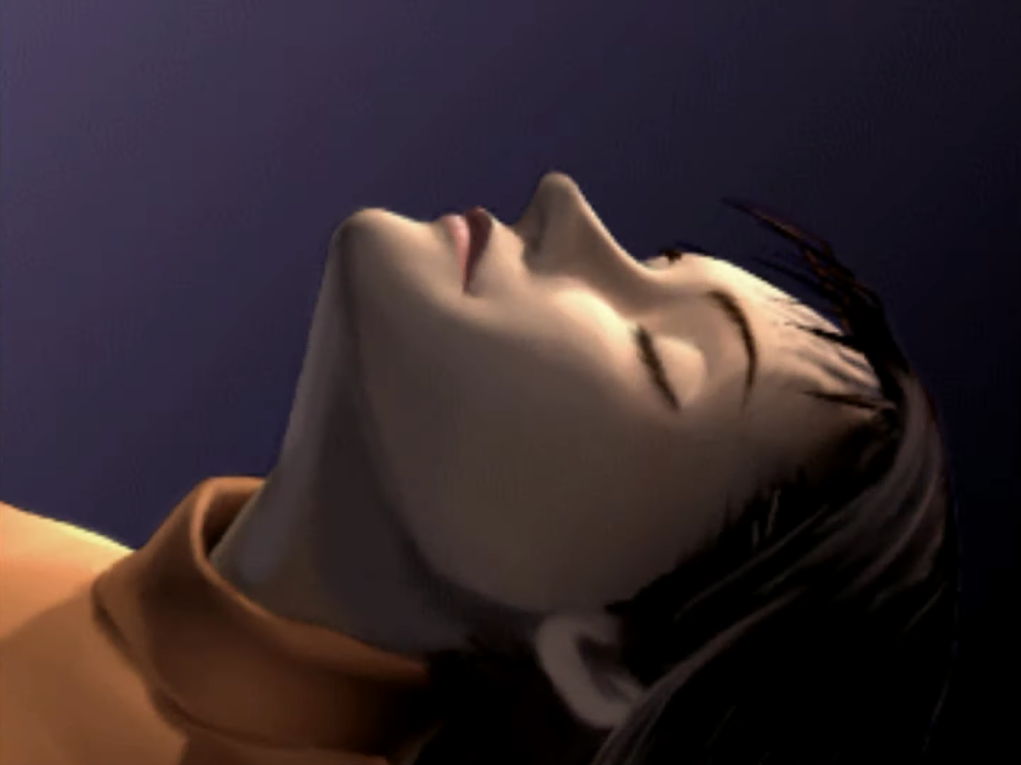
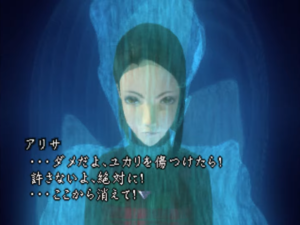
Leaving the apartment building, Yukari is confronted by the dark thought or presence that has enveloped it, once again represented by the vacuous eyes. Arisa protects her by exorcising them, revealing her own ESP powers. Again, the two reassess their situation, with Arisa explaining that while she came to save Yukari, Chisato instead went to rescue Mika.
We then cut to Chisato, on the roof of the building, talking to Riru, who has resolved to jump herself.
She reassures Chisato that she hasn’t hurt Mika, and insists that by killing herself she will put a stop to the suicides.
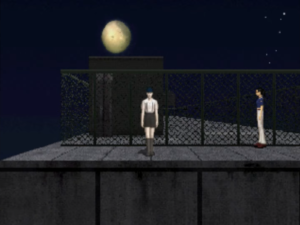
Chisato tries to talk her down by saying that people won’t care about the motivations behind her death, being too caught up in their own lives, making her sacrifice meaningless. Riru insists that there’s nothing else they can do; rather than live in fear and isolation, they’d rather dive in order to make a statement.
However Chisato, who is likely attuned to the spirits of the children who have come to haunt the building, insists that the release of death won’t grant her or any of the others peace. She even refers back to the sixth chapter of Twilight Syndrome, in which she interacted with a boy who had committed suicide due to bullying, in order to explain how taking one’s life is never a solution, because it brings no release.
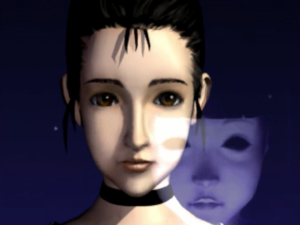
Riru does not relent, claiming that if death is meaningless then she shall give it meaning by making her dive the last one. Chisato eventually manifests the persona of Hanako-san in order to warn Riru about the afterlife.
Chisato’s connection to Hanako-san and the two being one and the same is quite a confusing point, much like Chisato’s nature as a Zoroastrian angel (although in this chapter she seems to refer to herself as very much human. Possibly just because she has taken the side of humanity and lived among them for so long.)
Suda has elaborated on it in the In-depth Guide Q&A.
Who are Chisato and Yayoi really? What is their connection to Mithra?
Source
Mithra, Yayoi and Chisato are gods who are part of the yazatas.
This was set up by having Yayoi and Chisato be Zoroastrian gods as the groundwork.
Strictly speaking, Yayoi is a fusion of Vayu (the wind god) and the Pairilas (witches), who are on the side of the evil god Angra Mainyu, while Chisato is a fusion of Hvar (the sun god) with Rashnu (an angel who symbolises justice), who is on the side of the good god Ahura Mazda.
This means that they are both fusions of gods who are part of Zurvan (time). Because of this, I decided to make them sisters.
※If you compare the gods’ nature of Zurvan to the blood flowing through their bodies, perhaps this makes them like sisters who share the same blood.
What is the meaning behind the image of Hanako-san overlapping with Chisato when Chisato and Lil are talking in Fuyou?
Think of Hanako-san herself from Twilight Syndrome as Chisato Itsushima. We made a highlights version of Twilight Syndrome in the past, and there’s a scene in the promotional movie on the disk that implies that Chisato is Hanako-san.
Chisato in Moonlight Syndrome is a yazata (a multitude of divine spirits), so does that make Hanako-san one of Chisato’s avatars?
Yes. She needed a temporary form to use as a messenger for the people living nearby, so she became Hanako-san.
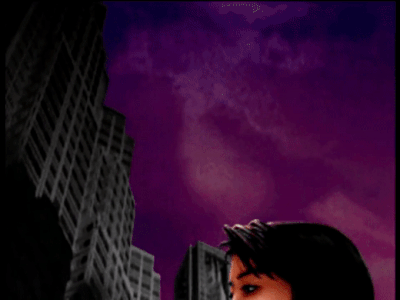
In other words, what he seems to be getting at is that Hanako-san is the persona or facet of Chisato that is her connection to the world of the dead. The promotional disc that he’s referring to is Twilight Syndrome The Memorize, in which an older Chisato Itsushima reminisces about the events of Twilight Syndrome.
Riru, having seen Hanako-san, identifies Chisato as an angel who is there to take her to the afterlife. Chisato, however, insists that she is a real human standing in front of her, trying to prevent her from dying.
Riru is happy to finally have someone worry about her well-being, but ultimately decides that it is too late for her and dives.

Outside the building, Yukari and Arisa witness Riru falling down. However, in a tragic twist of fate, Riru ends up falling in the arms of her own father, finally getting the hug she likely desired from him, but killing him in the process.
Yayoi confronts Chisato on the roof. Discussing the tragedy that just happened, Chisato once again accuses Yayoi of causing it. (She is correct on some level; Again we are told by Suda that Riru had, in fact, entered a contract with Mithra.)
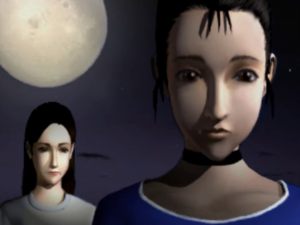
Yayoi denies the allegation by saying that it’s not in their (as in hers and Mithra’s) power to force anyone into anything, once again going back to the idea that Mithra is never the initiator of violence, instead being content with turning people’s inner desires against one another to cause tragedy. Yayoi describes herself as a mere onlooker, but when confronted by Chisato over her directly messing with Yukari, Yayoi simply responds that she got bored of just watching.
Chisato threatens Yayoi, who is unfazed. She claims she’s not scared of her older sister anymore since she’s stuck in the past. (Again, Chisato is shown as a very traditional girl, partaking in archery and singing enka songs during Twilight Syndrome. Meanwhile nightclubs, apartment complexes and other artifacts of modernity are Yayoi’s domain.)
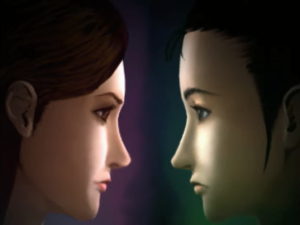
She also says that while Chisato might be able to stop her, there’s no way she can take on “him” (Mithra) implying that while the two sisters might be comparable in terms of power, Mithra exists above them as a higher being. The two enter a second spiritual battle.
The chapter ends on an ominous image of some kids sitting around the tv playing with their Playstation, as Mithra watches over them. These are probably the elementary-school kids that Riru mentioned earlier, Mithra’s presence implying that the madness that had captured the middle-schoolers will eventually envelop them as well.
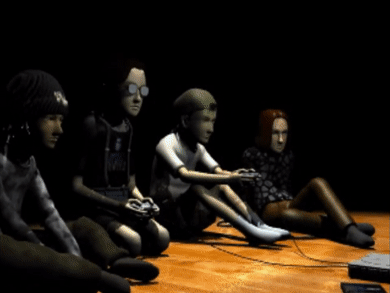
It is also the origin point of a specific symbol that we’ll see again in Suda’s career (namely in The 25th Ward and Killer7) in which the divine is portrayed as existing outside of the game world. (Literally, Mithra is in front of a Playstation console, which you’d be using to play the game. He also breaks the fourth wall during エピローグ EPILOGUE.)
This I think ties into Suda’s distaste for branching paths and “alternate endings”. Moonlight Syndrome has been criticized for lacking any of the investigative / interactive elements of its predecessors, but I actually think that was an intentional choice on Suda’s part, since his belief in the absurdity of alternate endings dates back to his very first outing as a writer, Super Fire Pro Wrestling Special.
In said game, the main character, a wrestler by the name of Morio Smith, manages to become the world wrestling champion and defeat the man who killed his teacher. However, having lost his friends and the love of his woman along the way, he is unable to overcome his suicidal depression and eventually kills himself.
According to the interview published in Continue Magazine no. 9, this extremely dark ending was initially planned as a “bad” ending which would change depending on the outcome of the final match. Suda, however, felt that the outcome of a match could not change the trajectory that the man’s life had taken by that point, and he subsequently decided to scrap the “good” ending, also due to his sentiments that the depiction of pro-wrestling was becoming too clean and childish.
(It should be noted that his usage of alternate endings in Killer7 and The 25th Ward seems to reinforce this point rather than undermine it, as the changes effected by the player are shown as ultimately meaningless in the former, and are portrayed as a complete joke in the latter. I’m not counting the original No More Heroes in this since the “unlockable” ending is just an extension of what is teased in the “bad” ending.)
He had similar criticisms of the writing in the original Twilight Syndrome games, which Moonlight was partially written as a response to. His comments in this E.goo interview from 2003 seem to imply that he disliked how, in order to give the player more “control” over outside events than a person would have in the real world, depictions of societal ills such as bullying and suicide had clear-cut, almost childishly optimistic resolutions.
This chapter especially feels like a response to that, not only due to the imagery of Mithra existing outside of the Playstation (thus existing outside of the player’s control), but in how the actions of Mika Kishii don’t actually end up “solving the case”. In fact her excitement over what is actually a gruesome and tragic episode is shown as immature and superficial, traits that she herself is ashamed of, and it is her moment of “maturity” in which she grows closer to Yukari that ends up positively influencing a third character (Takeru) into taking action and saving the person he cared for.
Yukari and Chisato are equally shown as unable to prevent Nana and Riru from diving; It is only through the sacrifice of Riru’s father, who might have consciously or unconsciously longed to protect his own daughter, that the mass suicides are stopped, and even then Riru will have to live with the guilt of having (although unwillingly) killed her own father, rather than be peacefully welcomed into the afterlife. Mithra looming over the younger children implies that the same madness will take a hold of them eventually. Nothing about this incident is clear cut, or even truly resolved.


